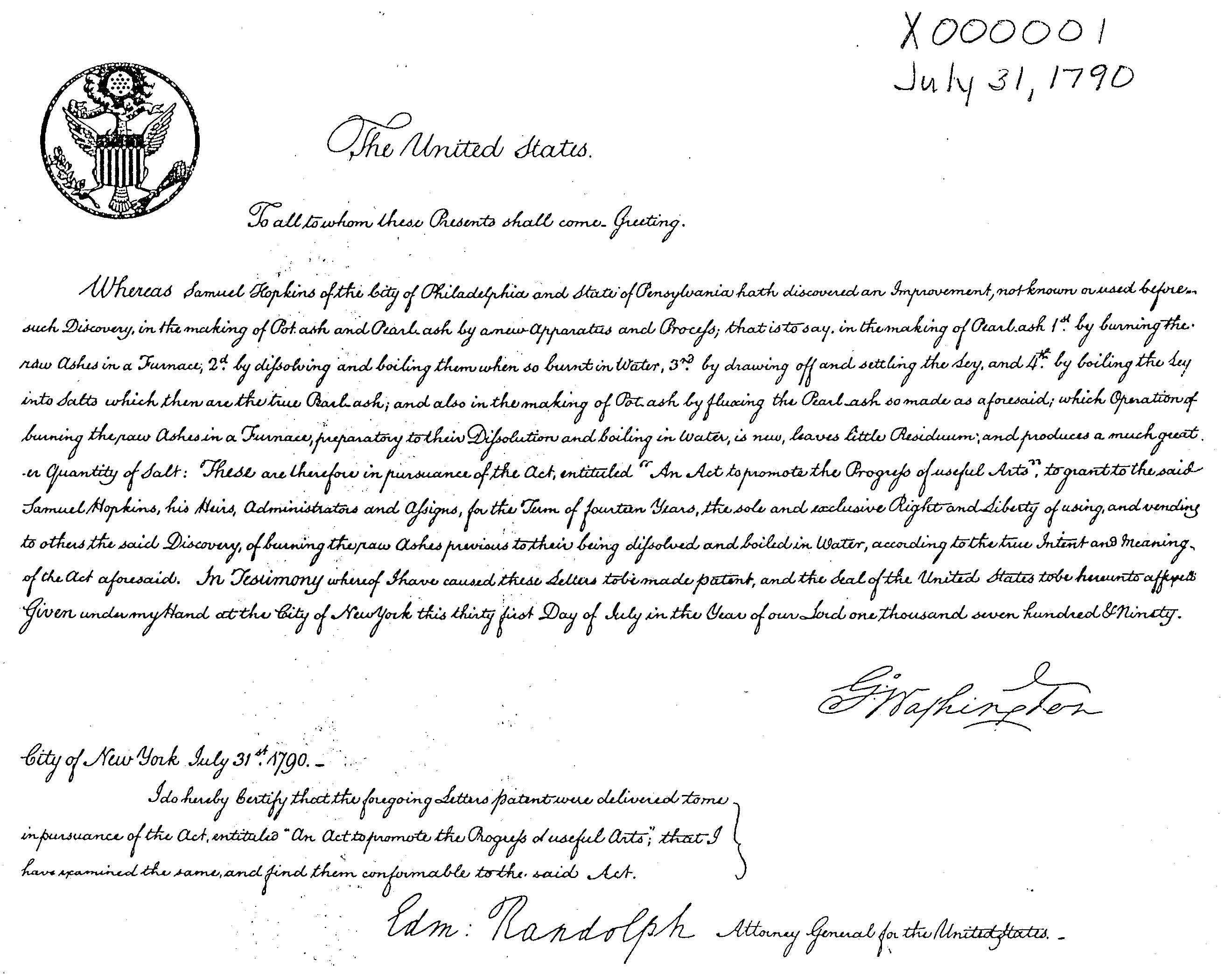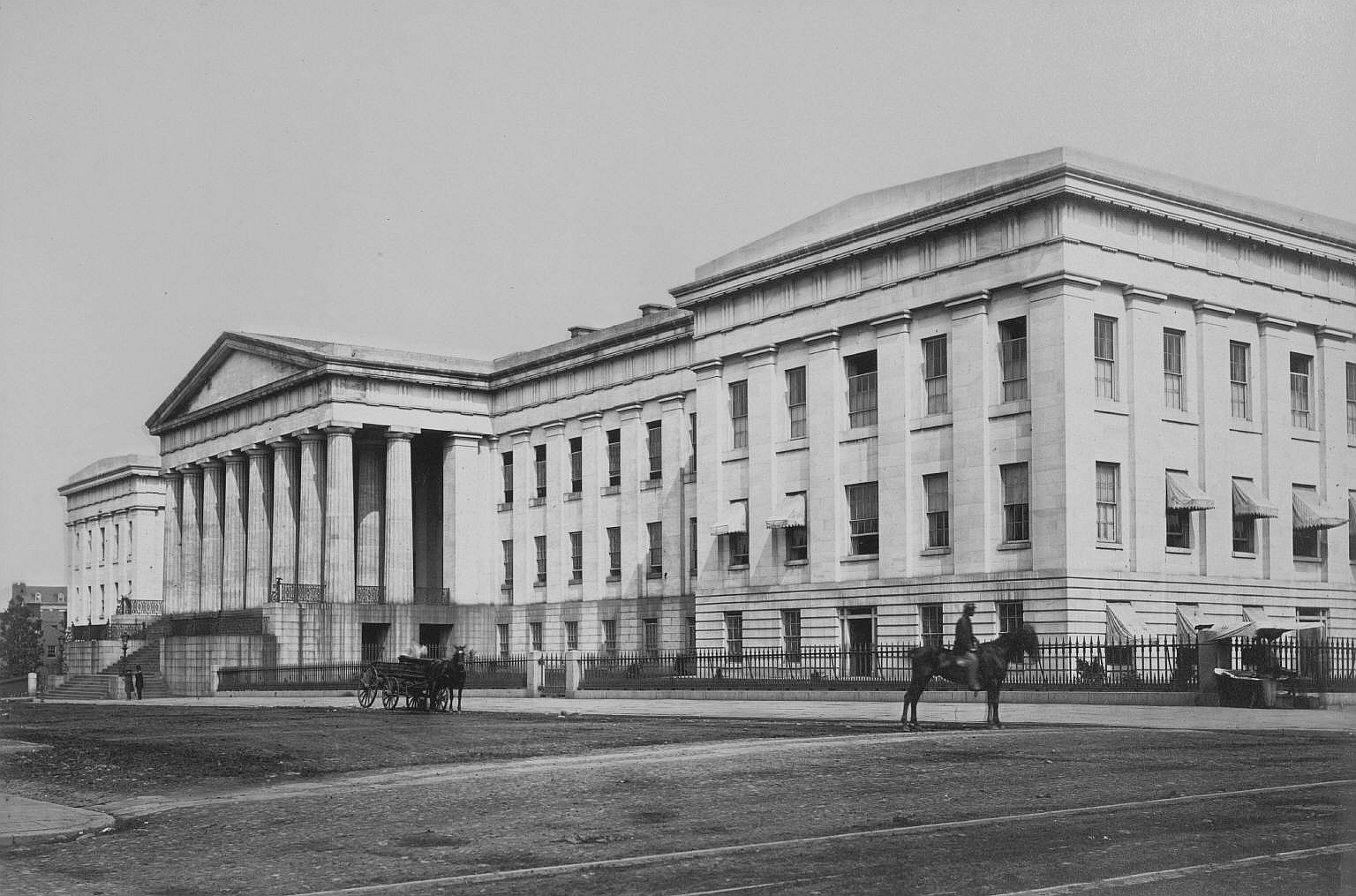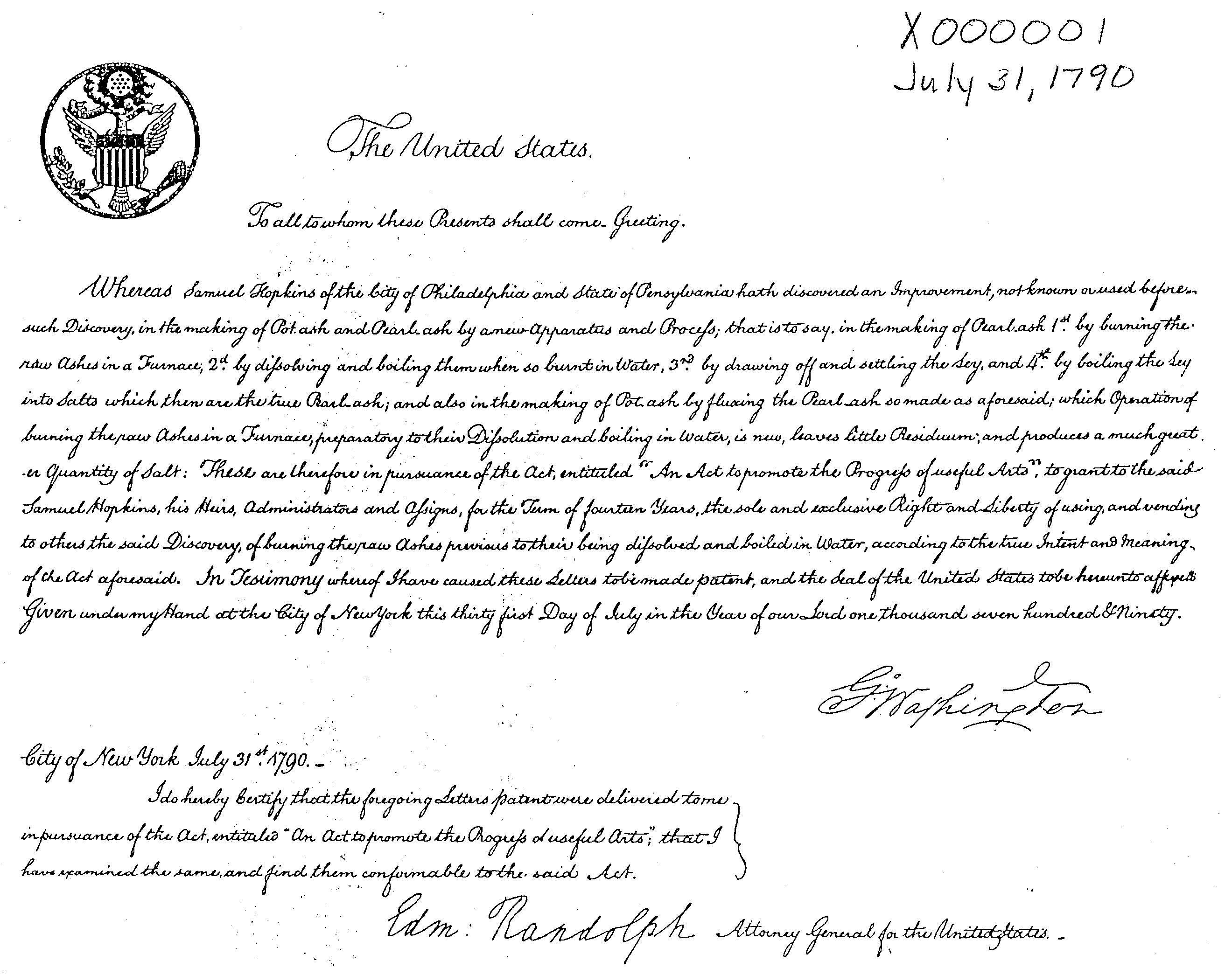|
Patent Act Of 1790
The Patent Act of 1790 () was the first patent statute passed by the federal government of the United States. It was enacted on April 10, 1790, about one year after the constitution was ratified and a new government was organized. The law was concise, defining the subject matter of a U.S. patent as "any useful art, manufacture, engine, machine, or device, or any improvement there on not before known or used."U.S. Patent System Celebrates 212 Years''”. The U.S. Patent and Trademark Office. 9 Apr. 2002 It granted the applicant the "sole and exclusive right and liberty of making, constructing, using and vending to others to be used" of his invention. [...More Info...] [...Related Items...] OR: [Wikipedia] [Google] [Baidu] |
United States
The United States of America (U.S.A. or USA), commonly known as the United States (U.S. or US) or America, is a country primarily located in North America. It consists of 50 states, a federal district, five major unincorporated territories, nine Minor Outlying Islands, and 326 Indian reservations. The United States is also in free association with three Pacific Island sovereign states: the Federated States of Micronesia, the Marshall Islands, and the Republic of Palau. It is the world's third-largest country by both land and total area. It shares land borders with Canada to its north and with Mexico to its south and has maritime borders with the Bahamas, Cuba, Russia, and other nations. With a population of over 333 million, it is the most populous country in the Americas and the third most populous in the world. The national capital of the United States is Washington, D.C. and its most populous city and principal financial center is New York City. Paleo-Americ ... [...More Info...] [...Related Items...] OR: [Wikipedia] [Google] [Baidu] |
United States Patent X1
United may refer to: Places * United, Pennsylvania, an unincorporated community * United, West Virginia, an unincorporated community Arts and entertainment Films * ''United'' (2003 film), a Norwegian film * ''United'' (2011 film), a BBC Two film Literature * ''United!'' (novel), a 1973 children's novel by Michael Hardcastle Music * United (band), Japanese thrash metal band formed in 1981 Albums * ''United'' (Commodores album), 1986 * ''United'' (Dream Evil album), 2006 * ''United'' (Marvin Gaye and Tammi Terrell album), 1967 * ''United'' (Marian Gold album), 1996 * ''United'' (Phoenix album), 2000 * ''United'' (Woody Shaw album), 1981 Songs * "United" (Judas Priest song), 1980 * "United" (Prince Ital Joe and Marky Mark song), 1994 * "United" (Robbie Williams song), 2000 * "United", a song by Danish duo Nik & Jay featuring Lisa Rowe Television * ''United'' (TV series), a 1990 BBC Two documentary series * ''United!'', a soap opera that aired on BBC One from 1965-19 ... [...More Info...] [...Related Items...] OR: [Wikipedia] [Google] [Baidu] |
Thomas Jefferson
Thomas Jefferson (April 13, 1743 – July 4, 1826) was an American statesman, diplomat, lawyer, architect, philosopher, and Founding Fathers of the United States, Founding Father who served as the third president of the United States from 1801 to 1809. He was previously the nation's second vice president of the United States, vice president under John Adams and the first United States Secretary of State, United States secretary of state under George Washington. The principal author of the United States Declaration of Independence, Declaration of Independence, Jefferson was a proponent of democracy, republicanism, and individual rights, motivating Thirteen Colonies, American colonists to break from the Kingdom of Great Britain and form a new nation. He produced formative documents and decisions at state, national, and international levels. During the American Revolution, Jefferson represented Virginia in the Continental Congress that adopted the Declaration of Independence. As ... [...More Info...] [...Related Items...] OR: [Wikipedia] [Google] [Baidu] |
Henry Knox
Henry Knox (July 25, 1750 – October 25, 1806), a Founding Father of the United States, was a senior general of the Continental Army during the Revolutionary War, serving as chief of artillery in most of Washington's campaigns. Following the revolution, he oversaw the War Department under the Articles of Confederation, 1785—1789. Washington, at the start of his first administration, appointed Knox the nation's first Secretary of War, a position he held from 1789—1794. He is perhaps best remembered today as the namesake of Fort Knox in Kentucky, the repository of a large portion of the nation's gold reserves. Born and raised in Boston, Massachusetts, Knox owned and operated a bookstore there, cultivating an interest in military history and joining a local artillery company. Knox was also on the scene of the 1770 Boston Massacre. Though barely 25 when the American Revolutionary War broke out in 1775, he engineered the transport of captured artillery from New York's Fort Ti ... [...More Info...] [...Related Items...] OR: [Wikipedia] [Google] [Baidu] |
Edmund Randolph
Edmund Jennings Randolph (August 10, 1753 September 12, 1813) was a Founding Father of the United States, attorney, and the 7th Governor of Virginia. As a delegate from Virginia, he attended the Constitutional Convention and helped to create the national constitution while serving on its Committee of Detail. He was appointed the first United States Attorney General by George Washington and subsequently served as the second Secretary of State during the Washington administration. Early life Randolph was born on August 10, 1753, to the influential Randolph family in Williamsburg in the Colony of Virginia. He was educated at the College of William and Mary. After graduation he began reading law with his father John Randolph and uncle, Peyton Randolph. In 1775, with the start of the American Revolution, Randolph's father remained a Loyalist and returned to Britain. Edmund Randolph returned to America where he joined the Continental Army as an aide-de-camp to General Geor ... [...More Info...] [...Related Items...] OR: [Wikipedia] [Google] [Baidu] |
Department Of State
The United States Department of State (DOS), or State Department, is an executive department of the U.S. federal government responsible for the country's foreign policy and relations. Equivalent to the ministry of foreign affairs of other nations, its primary duties are advising the U.S. president on international relations, administering diplomatic missions, negotiating international treaties and agreements, and representing the United States at the United Nations conference. Established in 1789 as the first administrative arm of the U.S. executive branch, the State Department is considered among the most powerful and prestigious executive agencies. It is headed by the secretary of state, who reports directly to the U.S. president and is a member of the Cabinet. Analogous to a foreign minister, the secretary of state serves as the federal government's chief diplomat and representative abroad, and is the first Cabinet official in the order of precedence and in the presiden ... [...More Info...] [...Related Items...] OR: [Wikipedia] [Google] [Baidu] |
Patent Office Fire Of 1836
The 1836 U.S. Patent Office fire was the first of two major fires the U.S. Patent Office has had in its history. It occurred in Blodget's Hotel building, Washington on December 15, 1836. An initial investigation considered the possibility of arson due to suspected corruption in the Post Office, which shared the same building, but it was later ruled out. The cause was ultimately determined to be accidental. The fire is considered to be a unique point in the historical events of the Patent Office that caused policy changes. Local fire suppression efforts were incapable of preventing the damage due to lack of fire personnel and proper equipment. Many patent documents and models from the preceding three decades were irretrievably lost. As a result of the fire, Congress and the newly legally revamped Patent Office changed the way it handled its record keeping, assigning numbers to patents and requiring multiple copies of supporting documentation. History In 1810, Congress authorize ... [...More Info...] [...Related Items...] OR: [Wikipedia] [Google] [Baidu] |
Samuel Hopkins (inventor)
Samuel Hopkins (December 9, 1743 – 1818) was an American inventor from Philadelphia, Pennsylvania, On July 31, 1790, he was granted the first U.S. patent, under the new U.S. patent statute just signed into law by President Washington on April 10, 1790. Hopkins had petitioned for a patent on an improvement "in the making of Pot ash and Pearl ash by a new Apparatus and Process." The statute did not create a Patent Office. Instead a committee of the Secretary of State, Secretary of War and the Attorney General were authorized to make a decision on the merit of a properly documented petition. The patent was signed by President George Washington, Attorney General Edmund Randolph, and Secretary of State Thomas Jefferson. The other U.S. patents issued that year were for a new candle-making process and Oliver Evans's flour-milling machinery. Hopkins also received the first "Canadian" patent from the Parliament of Lower Canada in 1791, issued "by the Governor General in Council to ... [...More Info...] [...Related Items...] OR: [Wikipedia] [Google] [Baidu] |
Potash
Potash () includes various mined and manufactured salts that contain potassium in water-soluble form.Potash USGS 2008 Minerals Yearbook The name derives from ''pot ash'', plant ashes or soaked in water in a pot, the primary means of manufacturing potash before the . The word '''' is derived from ''potash''. Potash is produced worldwide in amounts exceeding 90 million |
Oliver Evans
Oliver Evans (September 13, 1755 – April 15, 1819) was an American inventor, engineer and businessman born in rural Delaware and later rooted commercially in Philadelphia. He was one of the first Americans building steam engines and an advocate of high pressure steam (vs. low pressure steam). A pioneer in the fields of automation, materials handling and steam power, Evans was one of the most prolific and influential inventors in the early years of the United States. He left behind a long series of accomplishments, most notably designing and building the first fully automated industrial process, the first high-pressure steam engine, and the first (albeit crude) amphibious vehicle and American automobile. Born in Newport, Delaware, Evans received little formal education and in his mid-teens was apprenticed to a wheelwright. Going into business with his brothers, he worked for over a decade designing, building and perfecting an automated mill with devices such as bucket chains a ... [...More Info...] [...Related Items...] OR: [Wikipedia] [Google] [Baidu] |
United States Patent Law
Under United States law, a patent is a right granted to the inventor of a (1) process, machine, article of manufacture, or composition of matter, (2) that is new, useful, and non-obvious. A patent is the right to exclude others, for a limited time (usually, 20 years) from profiting of a patented technology without the consent of the patent-holder. Specifically, it is the right to exclude others from: making, using, selling, offering for sale, importing, inducing others to infringe, applying for an FDA approval, and/or offering a product specially adapted for practice of the patent. United States patent law is codified in Title 35 of the United States Code, and authorized by the U.S. Constitution, in Article One, section 8, clause 8, which states: Patent law is designed to encourage inventors to disclose their new technology to the world by offering the incentive of a limited-time monopoly on the technology. For U.S. utility patents, this limited-time term of patent i ... [...More Info...] [...Related Items...] OR: [Wikipedia] [Google] [Baidu] |
Patent Act Of 1836
The Patent Act of 1836 () established a number of important changes in the United States patent system. These include: *The examination of patent applications prior to issuing a patent. This was the second time this was done anywhere in the world. The only other time an examination period existed prior to this act was in the United States from 1790 to 1793 under the Patent Act of 1790. Prior to this, patents were issued on all applications, even if they were direct copies of earlier patents.Waltersheid, Edward C. (1998) ''To Promote the Progress of Useful Arts, American Patent Law and Administration'' Littleton: Rothman pp 3. It was left to the courts to decide validity in the event of a lawsuit. *The option of extending an existing patent's term for an additional seven years, making the maximum term of patent 21 years. (This was abolished in 1861 and replaced with a single 17-year term.) *The hiring of professional patent examiners. Initially only one examiner was hired, but soo ... [...More Info...] [...Related Items...] OR: [Wikipedia] [Google] [Baidu] |







